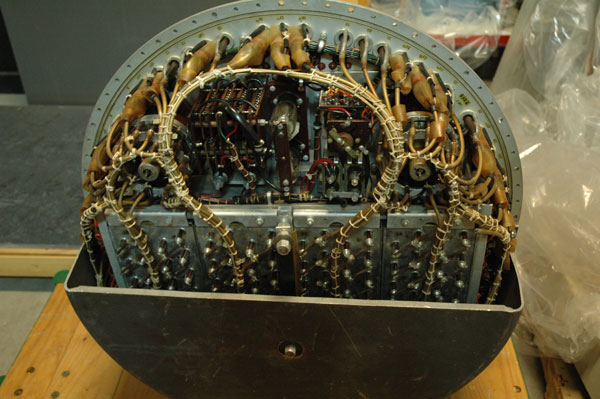On a recent trip to the Bradbury Science Museum in Los Alamos, Bill Lightfoot came across something surprising. On display was one of the firesets, or electronic fuses, that his father, William F. Lightfoot, worked on for the Raytheon Company during the Manhattan Project.
Bill Lightfoot remarks, “I had been told by a Raytheon rep years ago that there were probably no devices left or probably even any drawings or photos. You can imagine how stunned I was!”
An important component of the design of the “Fat Man” implosion bomb, the firesets supplied energy to the bomb’s detonators, which then compressed a mass of plutonium-239 to trigger a nuclear chain reaction and explosion. Raytheon produced hundreds of firesets for the Manhattan Project. The fireset at the Bradbury may be the only one still remaining. The 509th Composite Group used many of the other firesets in the “pumpkin bomb” tests it conducted to prepare for the use of the atomic bombs against Japan. The term “pumpkin bomb” applies to both the dummy concrete bombs used at Wendover, and the HE filled ones dropped over Japan.
The fireset was uncovered approximately ten years ago in a storage facility in Albuquerque. Sitting in an old crate, it was badly rusted, mouse-eaten, and in a pool of standing water – but still salvageable. Dr. Glen McDuff, the retired Los Alamos National Laboratory scientist who identified the fireset and helped restore it for display, speculates that it was stored away sometime in 1946. The device may have come from Wendover Airfield in Utah or the Naval Ordnance Testing Station at China Lake, California.
The fireset has a relatively low serial number (285), so McDuff believes it was from “one of the original batches.” It was probably never used, which may explain its unlikely survival. Normally, “as soon as it [a fireset] arrived, it was used,” McDuff says. He calls the fireset “probably the only one we are ever going to find.”
Raytheon and the Manhattan Project
The Raytheon Company, co-founded by Manhattan Project administrator Vannevar Bush, helped developed and refine technologies that were pivotal to Allied victory in World War II. These included radar and the equipment for nighttime aerial photography pioneered by MIT professor Harold “Doc” Edgerton.
Raytheon was approached to join the Manhattan Project after scientist Don Hornig realized that the company’s capacitors could be used in designing the switch for the implosion bomb. The “Fat Man” bomb used the same circuit employed in Edgerton’s aerial photography, but swapped out the flash lamp with a detonator (see graphic below). Percy Spencer, the inventor of the microwave oven, led Raytheon’s work on the fuses. The design for the firesets was “unbelievably complicated,” McDuff comments. “Nobody had ever done this.”
William F. Lightfoot was responsible for producing test equipment for the team working on the fuses. He traveled to Los Alamos on at least two occasions. In his memoir The First Half, his son remembers him being accompanied by a pair of armed FBI agents, “an indication of the importance that the government attached to my father’s knowledge.”
After the war, Lightfoot continued working at Raytheon, serving as director of government manufacturing. He also served as program manager of the avionics of the B-58 Hustler bomber program. He passed away in 1990 at the age of 83.
Thanks to Bill Lightfoot, Omar Juveland of the Bradbury Science Museum, and Dr. McDuff for sharing the story of the fireset with AHF. For more on the design of the “Fat Man” type bomb, please visit our page on the Science Behind the Atom Bomb.





